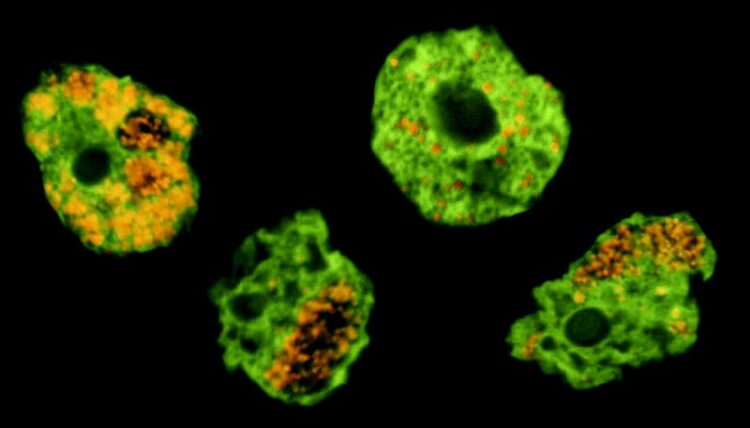Chlamydiae expand our view on how intracellular bacteria evolve

Chlamydiae, known as bacterial pathogens of humans, originally evolved in single-celled microorganisms long before gaining the ability to infect humans. The image shows soil amoeba (labeled in green) and their chlamydial symbionts (labeled in orange).
Credit: Eva Heinz
Despite being intracellular symbionts, some chlamydiae could gain important genes through gene transfer from other bacteria.
All chlamydiae today live inside the cells of hosts ranging from amoeba to animals. A team of scientists from the University of Vienna and the Wageningen University & Research found that the ancestor of chlamydiae likely already lived inside host cells, but that chlamydiae infecting amoeba evolved later in ways unexpected for intracellular bacteria. The study published in Nature Microbiology is an important step for understanding the emergence and evolution of endosymbiotic bacteria, including human pathogens.
Chlamydiae are known for the human pathogen Chlamydia trachomatis, but this group of bacteria evolved over a billion years ago—long before even the first animals. Nevertheless, all chlamydiae found today live inside a broad range of hosts from small amoeba to animal cells. But what has been puzzling scientists since the first chlamydiae genomes were sequenced 20 years ago is that, while chlamydiae infecting animals have small genomes similar to other endosymbionts, those that infect amoeba have larger genome sizes more similar to free-living bacteria. The study of this diverse bacterial group’s evolution, however, has been hampered by the difficulty to grow these microbes in the lab.
The teams around Matthias Horn (University of Vienna) and Thijs Ettema (Wageningen University & Research) could circumvent this problem: “We’ve only recently gained the capability to sequence genomes directly from environmental samples to explore the breadth of chlamydial diversity,” explain the researchers. With this new data in hand, they then traced back the evolution of chlamydiae. Using state-of-the-art computational methods, they reconstructed the genome of the last common ancestor of all known chlamydiae. The researchers found that “this extinct microbe had all the genes needed to be an endosymbiont. Even genes important for chlamydial animal pathogens today were likely already present.” This means that chlamydiae have been infecting host cells for over a billion years of evolutionary history.
However, to their surprise the research team also found that chlamydiae infecting amoeba gained many metabolic genes only later, despite the fact that endosymbionts have fewer opportunities to exchange genes with other bacteria. “Our results show that more gene exchange happened in some chlamydiae than expected for endosymbionts,” the authors explain, “including the gain of key metabolic genes”.
This result challenges how we think about the evolution of endosymbionts. But the researchers also suggest a solution to this conundrum: “It’s not so surprising when you think about the environment these chlamydiae live in: Amoeba often host multiple endosymbionts and feed on free-living bacteria, so there are other microbes around increasing the accessible gene pool. In addition, most chlamydiae move between different hosts, and exposure to changing environments could explain why it might be beneficial for these endosymbionts to keep and even gain additional metabolic genes.”
The scientists are curious to see whether this mode of endosymbiont evolution is more widespread. In any case, this study is an important step for understanding the emergence and evolution of endosymbiotic bacteria, including human pathogens.
Journal: Nature Microbiology
DOI: 10.1038/s41564-022-01284-9
Article Title: Gene gain facilitated endosymbiotic evolution of Chlamydiae.
Article Publication Date: 5-Jan-2023
Media Contact
Veronika Schallhart
University of Vienna
presse@univie.ac.at
Office: +43-1-4277-175 30
Original Source
Media Contact
All latest news from the category: Life Sciences and Chemistry
Articles and reports from the Life Sciences and chemistry area deal with applied and basic research into modern biology, chemistry and human medicine.
Valuable information can be found on a range of life sciences fields including bacteriology, biochemistry, bionics, bioinformatics, biophysics, biotechnology, genetics, geobotany, human biology, marine biology, microbiology, molecular biology, cellular biology, zoology, bioinorganic chemistry, microchemistry and environmental chemistry.
Newest articles

Innovative 3D printed scaffolds offer new hope for bone healing
Researchers at the Institute for Bioengineering of Catalonia have developed novel 3D printed PLA-CaP scaffolds that promote blood vessel formation, ensuring better healing and regeneration of bone tissue. Bone is…

The surprising role of gut infection in Alzheimer’s disease
ASU- and Banner Alzheimer’s Institute-led study implicates link between a common virus and the disease, which travels from the gut to the brain and may be a target for antiviral…

Molecular gardening: New enzymes discovered for protein modification pruning
How deubiquitinases USP53 and USP54 cleave long polyubiquitin chains and how the former is linked to liver disease in children. Deubiquitinases (DUBs) are enzymes used by cells to trim protein…



